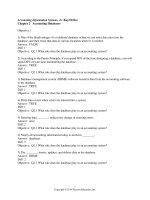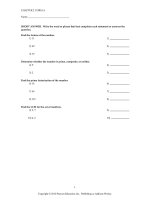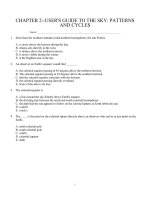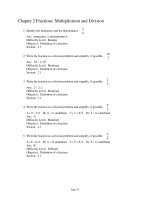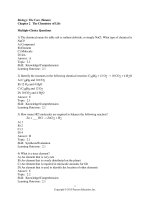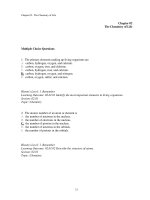Discovering the humanities 2nd edition sayre test bank
Bạn đang xem bản rút gọn của tài liệu. Xem và tải ngay bản đầy đủ của tài liệu tại đây (784.54 KB, 25 trang )
Test Item File
for
Discovering the Humanities
By
Henry Sayre
Second Edition
by
Nathan Poage
Houston Community College
1
Copyright © 2013 Pearson Education, Inc., Upper Saddle River, NJ 07458. All rights reserved.
© 2013 by PEARSON EDUCATION, INC.
Upper Saddle River, New Jersey 07458
All rights reserved
10 9 8 7 6 5 4 3 2 1
ISBN 0-205-21965-9
Printed in the United States of America
2
Copyright © 2013 Pearson Education, Inc., Upper Saddle River, NJ 07458. All rights reserved.
Table of Contents
Chapter 1
4
Chapter 2
14
Chapter 3
25
Chapter 4
31
Chapter 5
40
Chapter 6
48
Chapter 7
55
Chapter 8
65
Chapter 9
71
Chapter 10
79
Chapter 11
87
Chapter 12
97
Chapter 13
104
Chapter 14
111
Chapter 15
118
3
Copyright © 2013 Pearson Education, Inc., Upper Saddle River, NJ 07458. All rights reserved.
Chapter 1: The Prehistoric Past and the Earliest Civilizations:
The River Cultures of the Ancient World
Multiple Choice Questions
1. Which of the following is NOT the location of a cave in which ancient paintings have been
discovered?
a. Chauvet, France
b. Lascaux, France
c. Altamira, Spain
d. Pitlochry, Scotland
Answer: d
page 2
2. How does culture manifest itself?
a. in the biology of a people
b. in the geography of a place
c. in the laws, customs, ritual behavior, and artistic productions of a group
d. only in architecture
Answer: c
page 2
3. Which of the following cave paintings depicts a human figure wearing a birds-head mask?
a. Cosquer, France
b. Lascaux, France
c. Chauvet, France
d. Altamira, Spain
Answer: b
page 3
4. What are the paintings in Chauvet known especially for?
a. their location
b. their colors
c. their attention to detail
d. their naturalism
Answer: d
page 3
5. Where was evidence of the earliest hominids found?
a. Iran
b. France
c. Spain
d. Ethiopia
Answer d.
page 4
6. In which of the following nations was the Willendorf Venus discovered?
a. Spain
4
Copyright © 2013 Pearson Education, Inc., Upper Saddle River, NJ 07458. All rights reserved.
b. Ukraine
c. France
d. Austria
Answer: d
page 4
7. What color was the Willendorf Venus originally painted?
a. black
b. white
c. burnt umber
d. red ochre
Answer: d
page 4
8. Which feature on the Willendorf Venus was NOT carved, but instead a natural indentation in
the stone?
a. the nose
b. the navel
c. the hair
d. the chin
Answer: b
page 5
9. In which of the following regions did an agricultural society LAST develop?
a. southern France
b. the Indus River valley
c. England
d. the Nile River valley
Answer: c
page 6
10. Which of the following nations is mentioned as a source for painted pottery that
featured highly stylized animals, including the ibex?
a. France
b. Iran
c. Austria
d. Japan
Answer: b
page 6
11. In which area were Neolithic ceramics discovered in Africa?
a. South Africa
b. Tanzania
c. Ivory Coast
d. Nigeria
Answer: d
page 6
12. Which of the following terms refers to one of the “big stones” used in the construction of a
5
Copyright © 2013 Pearson Education, Inc., Upper Saddle River, NJ 07458. All rights reserved.
site such as Stonehenge?
a. megalith
b. menhir
c. cairn
d. cromlech
Answer: a
page 7
13. Which of the following terms refers to the category of megalithic structure that includes
Stonehenge?
a. dolmen
b. menhir
c. cairn
d. cromlech
Answer: d
page 8
14. What is likely to be the purpose of Stonehenge?
a. a crop circle
b. an astronomical chart
c. a burial ground
d. a temple
Answer: c
page 8
15. Which area is considered to be a pairing with Stonehenge?
a. Durrington Wells
b. Wells
c. Salisbury
d. Bath
Answer: a
page 9
16. Which of the following best defines myth?
a. a religious parable
b. a factual recounting of origin
c. an intentional fabrication
d. a story that a culture assumes is true
Answer: d
page 9
17. Which of the following ancient cultures lived in cliff dwellings and considered the kiva, a
partly underground ceremonial enclosure with a hole in the floor that symbolizes the
emergence of the people from the underworld?
a. the Jomon
b. the Anasazi
c. the Olmec
d. the Woodlands peoples
6
Copyright © 2013 Pearson Education, Inc., Upper Saddle River, NJ 07458. All rights reserved.
Answer: b
page 10
18. Which of the following terms refers to what the Zuni Pueblo people consider deified spirits
who manifest themselves in performance and dance?
a. kachinas
b. kivas
c. menhirs
d. cairns
Answer: a
page 11
19. Which of the following rivers is associated with ancient India?
a. the Nile
b. the Euphrates
c. the Indus
d. the Yellow
Answer: c
page 2
20. Which of the following rivers is associated with ancient China?
a. the Nile
b. the Euphrates
c. the Indus
d. the Yellow
Answer: d
page 2
21. On which of the following continents did the Anasazi build their cliff dwellings?
a. Africa
b. South America
c. North America
d. Europe
Answer: c
page 9
22. Which of the following rivers is associated with ancient Mesopotamia?
a. the Yellow
b. the Nile
c. the Indus
d. the Tigris
Answer: d
page 14
23.
a.
b.
c.
d.
Which of the following was the resident god at Ur?
Abu, god of vegetation
Belitili, goddess of fertility
Anu, the father of the gods
Sin, the god of the moon
7
Copyright © 2013 Pearson Education, Inc., Upper Saddle River, NJ 07458. All rights reserved.
Answer: d
page 14
24. Which of the following terms refers to a religion that includes many gods and goddesses
often associated with natural forces and realms?
a. monotheism
b. theocracy
c. henotheism
d. polytheism
Answer: d
page 16
25. Among the following residents of Mesopotamia, which was the only monotheistic group?
a. the Akkadians
b. the Assyrians
c. the Hebrews
d. the Babylonians
Answer: c
page 16
26. Which of the following pairs correctly identifies the subjects illustrated in the two main
panels of the rectangular box known as the Standard of Ur?
a. “Winter” and “Summer”
b. “Heaven” and “Earth”
c. “Planting” and “Harvest”
d. “War” and “Peace”
Answer: d
page 16
27.
Which of the following terms refers to the pictorial convention in which the most
important figures are represented in a larger size than the others?
a. pictogram
b. hieratic of scale
c. double entendre
d. phonetic writing
Answer: b
page 17
28. Which of the following leaders guided the Akkadians to conquer virtually all other cities in
Mesopotamia and named himself “King of the Four Quarters of the World”?
a. Romulus
b. Remus
c. Sargon
d. Moses
Answer: c
page 17
29. Which of the following is considered the first existing monumental work made through the
lost-wax casting technique?
8
Copyright © 2013 Pearson Education, Inc., Upper Saddle River, NJ 07458. All rights reserved.
a. the dedicatory statues from the Abu Temple
b. the Cylinder Seal of Adda
c. the Standard of Ur
d. the Head of an Akkadian Man
Answer: d
page 18
30.
Who is considered responsible for having introduced the principle of talion to
Mesopotamian culture?
a. Hammurabi
b. Sargon
c. Gudea
d. Naramsin
Answer: a
page 18
31.
What best defines the epic element an epithet?
a. a word or phrase that characterizes a person
b. a word that compares two unlike things
c.
a word or phrase used to suggest a similarity between two things
d. a word that treats a part of a thing as the whole of the thing
Answer: a
page 20
32. Who among the following is recognized as the original human author of the Hebrew
Torah?
a. Noah
b. Moses
c. Abraham
d. Adam
Answer: b
page 24
33. Which among the following is not a book of the Torah?
a. Genesis
b. Exodus
c. Judges
d. Deuteronomy
Answer: c
page 24
34. Which of the following is the son of King David and is also the person who built the
magnificent temple in Jerusalem?
a. Solomon
b. Saul
c. Samuel
d. Moses
Answer: a
page 25
9
Copyright © 2013 Pearson Education, Inc., Upper Saddle River, NJ 07458. All rights reserved.
35. Which of the following armies captured Jerusalem, destroyed its temple, and deported
many of the Hebrews?
a. the Assyrians
b. the Persians
c. the Babylonians
d. the Hittites
Answer: c
page 25
36. Which of the following terms refers to a state ruled by a god or by the god’s representative?
a. monotheism
b. polytheism
c. henotheism
d. theocracy
Answer: d
page 28
37. Which of the following terms refers to a religion that includes many gods and goddesses
often associated with natural forces and realms?
a. monotheism
b. polytheism
c. henotheism
d. theocracy
Answer: b
page 29
38. In ancient Egyptian religion, which of the following ruled the underworld and was god of
the dead?
a. Osiris
b. Anubis
c. Horus
d. Seth
Answer: a
page 29
39. In ancient Egyptian religion, which of the following was the child of Osiris and Isis?
a. Re
b. Anubis
c. Horus
d. Seth
Answer: c
page 29
40. Which of the following ancient Egyptian leaders ruled circa 3,000 B.C.E. and is credited
with unifying both Upper and Lower Egypt?
a. Djoser
b. Khafre
10
Copyright © 2013 Pearson Education, Inc., Upper Saddle River, NJ 07458. All rights reserved.
c. Khufu
d. Narmer
Answer: d
page 32
41. In ancient Egyptian religion, which of the following was comparable to an enduring “soul”
or “life force,” a concept shared by many other religions?
a. ba
b. ka
c. maat
d. cartouche
Answer: b
page 30
42. Which of the following stone materials is NOT among those selected to create funerary
images in ancient Egypt?
a. granite
b. schist
c. diorite
d. sandstone
Answer: d
page 31
43. Which of the following is NOT among the changes imposed by Amenhotep IV because was
the king?
a. He changed his own name to Akhenaten.
b. He moved the capital of Egypt from Thebes to a new location.
c. He limited the priesthood to only twelve members.
d. He abolished the pantheon of Egyptian gods and established a monotheistic religion.
Answer: c
page 31
44. By what name do we know the new style of art that developed during the rule of
Amenhotep IV / Akhenaten?
a. the Hatshepsut style
b. the Karnak style
c. the Hyksos style
d. the Amarna style
Answer: d
page 34
45. Which of the following is NOT among Tutankhamun’s accomplishments?
a. He ruled Egypt for 65 years.
b. He moved the royal family to Memphis.
c. He reaffirmed Thebes as the nation’s religious center.
d. He changed his name from Tutankhaten.
Answer: a
page 34
11
Copyright © 2013 Pearson Education, Inc., Upper Saddle River, NJ 07458. All rights reserved.
46. If the deceased person’s heart did not balance with the ostrich feather in the ancient
Egyptian “last judgment,” the dead person was condemned to nonexistence and to be eaten
by Ammit. Which of the following animals is NOT part of this vile “Eater of the Dead”?
a. hippopotamus
b. crocodile
c. hawk
d. lion
Answer: c
page 35
Essay Questions
47. Discuss some of the possible explanations for the roles that cave drawings played in the
daily lives of the people who created them.
48. Discuss how the Chauvet drawings suggest that art does not necessarily evolve in a linear
progression from awkward beginnings to more sophisticated representations.
49. Female figurines outnumber representations of males in the Paleolithic era. Explain what
this situation suggests about the roles that women played in Paleolithic culture.
50. Explain how a consistent and predictable source of water allowed the people living along
the great rivers of the Middle East and Asia to pursue activities beyond providing for
their basic needs.
51. Identify what is referred to as “the first mechanical and technological breakthrough in
history,” and then explain how this machine would have a dramatic impact on the lives
of those who could use it well.
52. Discuss some of the insights that Stonehenge provides us about the Neolithic people who
created it.
53. If you had the chance to visit one of the sites mentioned in this chapter, which would
it be? Explain your reasons.
54. Discuss the importance of the Standard of Ur.
55. Discuss how the king's divine role in Akkadian culture is reflected in the Stele of Naramsin.
56. Discuss what the Law Code of Hammurabi tells us about family relations and class division in
Mesopotamian society.
12
Copyright © 2013 Pearson Education, Inc., Upper Saddle River, NJ 07458. All rights reserved.
57. Discuss the most significant effects that the Law Code of Hammurabi had on Mesopotamian
society.
58. Discuss the distinct differences between Hebraic and Mesopotamian laws—especially as
they relate to slaves and aliens.
59. What themes in the Epic of Gilgamesh can be found in later literature?
60. Discuss the chief characteristics of the Amarna style of art, focusing on their contrasts
with the characteristics of previous ancient Egyptian art.
61. List the most significant changes imposed by Amenhotep IV / Akhenaten when he
assumed the throne, and then discuss how these might have affected the royal
household, the priests, and the commoners.
62. How do the elements in the Palette of Narmer (See Closer Look, p.32-33) communicate the
power of the pharaoh?
13
Copyright © 2013 Pearson Education, Inc., Upper Saddle River, NJ 07458. All rights reserved.
Chapter 2: The Greek World: The Classical Tradition
Multiple Choice Questions
1. Which of the following Greek terms can be translated as "circle"?
a. kyklos
b. labrys
c. areté
d. tholos
Answer: a
page 41
2. Which of the following is the Greek term for city-state?
a. polis
b. acropolis
c. agora
d. politeia
Answer: a
page 39
3. Which of the following is the Greek term for an open meeting place?
a. polis
b. acropolis
c. metropolis
d. agora
Answer: d
page 39
4. Which of the following is the Greek term for “top of the city”?
a. polis
b. metropolis
c. acropolis
d. colonnade
Answer: c
page 39
5. Which of the following is the Greek term for “the good or flourishing life”?
a. arête
b. pistis
c. energeia
d. eudaimonia
Answer: d
page 40
6.
a.
b.
c.
Which of the following is NOT mentioned as being common among the people of Thera?
Their homes were elaborately decorated.
Clay pipes connected toilets and baths to sewers.
Blocks of ice were available for food storage.
14
Copyright © 2013 Pearson Education, Inc., Upper Saddle River, NJ 07458. All rights reserved.
d. Straw reinforced the walls of their homes.
Answer: c
page 41
7. Who is the legendary ruler of Crete's ancient capital, Knossos?
a. Priam
b. Minos
c. Aegeus
d. Agamemnon
Answer: b
page 42
8. Which of the following creatures did the inhabitants of Crete associate with male virility
and strength?
a. tigers
b. lions
c. bulls
d. horses
Answer: c
page 42
9. Which of the following Greek terms can be translated as "double ax"?
a. kyklos
b. tholos
c. areté
d. labrys
Answer: d
page 44
10. Which of the following ancient structures was known as the "House of the Double Axes"?
a. the palace of Priam at Troy
b. the palace of Minos at Knossos
c. the palace of Agamemnon at Mycenae
d. the palace of Theramos at Akrotiri
Answer: b
page 44
11. Which of the following is the legendary Minoan queen who gave birth to the Minotaur?
a. Pasiphae
b. Ariadne
c. Aegeus
d. Daedalus
Answer: a
page 44
12. Which of the following provided Theseus with a weapon and thread to help him kill the
Minotaur?
a. Aegeus
b. Daedalus
15
Copyright © 2013 Pearson Education, Inc., Upper Saddle River, NJ 07458. All rights reserved.
c. Ariadne
d. Pasiphae
Answer: c
page 44
13. Which of the following is credited with the discovery of Mycenae?
a. Sir Arthur Evans
b. King Minos
c. Napoleon
d. Heinrich Schliemann
Answer: d
page 45
14. Who is considered the author of the Iliad and the Odyssey?
a. Homer
b. Socrates
c. Plato
d. Aristotle
Answer: a
page 46
15. Which of the following is the central character in the Iliad, which focuses on his "rage"?
a. Agamemnon
b. Patroclus
c. Hector
d. Achilles
Answer: d
page 46
16. Which of the following Greek terms can be translated as "virtue," and can be interpreted as
"reaching one's highest potential"?
a. labrys
b. areté
c. tholos
d. kyklos
Answer: b
page 47
17. Who is best remembered as the King of Troy during the action of the Iliad?
a. Priam
b. Aegeus
c. Minos
d. Agamemnon
Answer: a
page 47
18. Who is the Trojan prince and warrior that killed Patroclus and enraged Achilles during the
action of the Iliad?
16
Copyright © 2013 Pearson Education, Inc., Upper Saddle River, NJ 07458. All rights reserved.
a. Agamemnon
b. Menelaus
c. Hector
d. Priam
Answer: c
page 47
19. Which of the following is the name for a Greek vase with two handles?
a. amphora
b. arête
c. labrys
d. pyx
Answer: d
page 47
20. Who is the wife of Odysseus?
a. Helen
b. Penelope
c. Pasiphae
d. Ariadne
Answer: b
page 48
21. Which of the following ancient structures is a citadel city that depended on cyclopean
masonry for its construction and was entered through a massive Lion Gate?
a. the ancient city of Mycenae
b. the palace of Minos at Knossos
c. the ancient city of Troy
d. the palace of Theramos at Akrotiri
Answer: a
page 45
22. Who is the chief craftsperson that assists the Minoan queen in her plan to attract the
Minotaur?
a. Aegeus
b. Ariadne
c. Daedalus
d. Theseus
Answer: c
page 44
23. During the action of the Iliad, who is considered the greatest warrior among the Greeks
battling against the Trojans?
a. Menelaus
b. Agamemnon
c. Odysseus
d. Achilles
Answer: d
page 46
17
Copyright © 2013 Pearson Education, Inc., Upper Saddle River, NJ 07458. All rights reserved.
24. Which of the following literary pieces was first to detail the Greek pantheon?
a. the Iliad
b. the Odyssey
c. Works and Days
d. Theogony
Answer: d
page 49
25. Which of the following terms translates as the sin of pride?
a. agora
b. acropolis
c. homoioi
d. hubris
Answer: b
page 49
26. Which of the following terms refers to the portion of an ancient Greek city-state that served
as public meeting place, marketplace, and civic center?
a. agora
b. acropolis
c. homoioi
d. helots
Answer: a
page 39
27. Which of the following is not among the Greek pantheon?
a. Isis
b. Dionysus
c. Hermes
d. Poseidon
Answer: a
page 49
28. Which of the following is described as the “King of the gods”?
a. Hera
b. Zeus
c. Hades
d. Bendis
Answer: b
page 49
29. Which of the following is described as “the God of wine and inspiration”?
a. Hermes
b. Apollo
c. Dionysus
d. Hesphaestus
Answer: c
page 49
18
Copyright © 2013 Pearson Education, Inc., Upper Saddle River, NJ 07458. All rights reserved.
30. Which ancient Greek city-state built a towpath to drag ships over a series of rollers as an aid
to those who traveled by sea?
a. Athens
b. Delphi
c. Thebes
d. Corinth
Answer: d
page 50
31. Which ancient Greek city-state was the home to the Sanctuary of Apollo?
a. Athens
b. Delphi
c. Thebes
d. Corinth
Answer: b
page 50
32. In ancient Greek architecture, which of the following orders featured scrolled capitals?
a. Corinthian
b. Doric
c. Ionic
d. Composite
Answer: c
page 53
33. Which of the following terms refers to the row of columns that stands on the raised platform
of an ancient Greek temple?
a. caryatids
b. entasis
c. stylobate
d. peristyle
Answer: d
page 52
34. On an ancient Greek temple, the columns swell about one-third of the way up and contract
again near the top. Which of the following terms refers to this characteristic?
a. caryatids
b. entasis
c. stylobate
d. peristyle
Answer: b
page 51
35. On the krater that shows The Death of Sarpedon (painted by Euphronius and made by the
potter Euxitheos), which of the following is NOT included in the scene?
a. Thanatos
b. Odysseus
19
Copyright © 2013 Pearson Education, Inc., Upper Saddle River, NJ 07458. All rights reserved.
c. Hypnos
d. Hermes
Answer: b
page 56
36. Who instituted the first Athenian democracy in 508 BCE?
a. Kleisthenes
b. Peisistratus
c. Hippias
d. Pericles
Answer: a
page 57
37. Which of the following translates the Greek “rule of the people”?
a. arête
b. eudaimonia
c. anarchy
d. democracy
Answer: d
page 57
38. Which of the following terms became part of the Athenian political system and refers to
small local areas comparable to precincts or wards in a modern city?
a. kouroi
b. korai
c. demes
d. poleis
Answer: c
page 58
39. At the time of the decisive battle of Marathon in 490 BCE, who ruled the Persians?
a. Miltiades
b. Phidippides
c. Themistocles
d. Darius
Answer: d
page 58
40. Following the decisive battle of Marathon in 490 BCE, who ran the 26 miles between
Marathon and Athens to deliver word of the Greek victory to the anxious citizens of
Athens?
a. Miltiades
b. Phidippides
c. Themistocles
d. Darius
Answer: b
page 58
41. Who is the author of an extensive Histories and is recognized as the first writer in the
20
Copyright © 2013 Pearson Education, Inc., Upper Saddle River, NJ 07458. All rights reserved.
Western tradition who devoted himself to historical writing?
a. Herodotus
b. Hesiod
c. Aeschylus
d. Homer
Answer: a
page 58
42. Who cast the bronze statue known as Doryphoros (Spear bearer), which was celebrated
throughout the ancient world as a demonstration of a treatise on proportions of the human
body?
a. Kritios
b. Phidias
c. Thales
d. Polyclitus
Answer: d
page 62
43. On the Athenian Acropolis, which of the following was considered the centerpiece?
a. the Propylaia
b. the Parthenon
c. the Erechtheion
d. the Temple of Athena Nike
Answer: b
page 60
44. On the Athenian Acropolis, which of the following served as a monumental entryway to the
complex?
a. the Propylaia
b. the Parthenon
c. the Erechtheion
d. the Temple of Athena Nike
Answer: a
page 61
45. Which of the following is NOT included among those illustrated in the metopes on the four
sides of the Parthenon?
a. centaurs
b. Amazons
c. Trojans
d. Vikings
Answer: d
page 64
46. Which of the following was NOT among the accusations that Socrates faced when he was
placed on trial?
a. subversive behavior
b. corrupting young men
21
Copyright © 2013 Pearson Education, Inc., Upper Saddle River, NJ 07458. All rights reserved.
c. stealing from the treasury
d. introducing new gods
Answer: c
page 65
47. Among the pre-Socratics in the fifth century BCE, who conceived of an atomic theory in
which everything is made up of small, indivisible particles and empty space?
a. Plato
b. Protagoras
c. Heraclitus
d. Leucippus
Answer: d
pages 65
48. Who is responsible for one of the most famous of all Greek dictums: "Man is the measure of
all things"?
a. Democritus
b. Protagoras
c. Heraclitus
d. Leucippus
Answer: b
pages 66
49. Who specialized in writing comedies and is the playwright for Lysistrata?
a. Aristophanes
b. Euripides
c. Aeschylus
d. Sophocles
Answer: a
page 68
50. Who is the playwright for the Oresteia trilogy that includes events after Agamemnon's
return from the Trojan War?
a. Aristophanes
b. Euripides
c. Aeschylus
d. Sophocles
Answer: c
page 68
51. In the ancient Greek theater, what term identifies the elevated platform on which the actors
performed?
a. skene
b. parados
c. orchestra
d. proscenium
Answer: d
page 69
22
Copyright © 2013 Pearson Education, Inc., Upper Saddle River, NJ 07458. All rights reserved.
52. Rumors about the forces of the kingdom of the Ganges discouraged Alexander's army from
advancing farther to the east in the Indian peninsula. What imposing component might this
Ganges army have included?
a. 5,000 archers
b. 5,000 lancers
c. 5,000 elephants
d. 5,000 horse-drawn chariots
Answer: c
page 71
53. According to Aristotle's Poetics, who undergoes the catharsis (the cleansing, purification, or
purgation of the soul)?
a. the protagonist
b. the antagonist
c. the chorus
d. the audience
Answer: d
page 73
Essay Questions
54. Consider the reconstruction drawing and floor plan of the new palace complex at
Knossos, and then comment on why the legend of the Minotaur includes a maze where
the creature lived.
55. Explain the importance of areté among the ancient Greeks. Cite specific instances in which
it appears in the Iliad and the Odyssey.
56. If you had the chance to join an archaeological expedition to one of the ancient sites
mentioned in this chapter, which would it be? Explain your reasons.
57. Discuss several ways in which the ancient Greek gods might be considered "more human
than humans."
58. Investigate the towpath at Corinth and then comment on how this innovation would have
benefited the local economy and sea travel at large.
59. Explain the important role that the Pythia held in ancient Greek society.
60. Summarize the features that distinguish the capitals found on the Doric, Ionic, and
Corinthian columns.
61. Summarize the features that distinguish the kouros and the kore, citing the development in
clothing worn by korai.
23
Copyright © 2013 Pearson Education, Inc., Upper Saddle River, NJ 07458. All rights reserved.
62.. Summarize the accomplishments of Sappho, who was hailed throughout antiquity as the
"tenth Muse.”
63. Summarize Plato's model of the ideal state as he presents in the "Allegory of the Cave."
64. Discuss identity and change as they relate to essence in Aristotle's view of the world.
65. Discuss how the Golden Mean relates to the ancient Greek's concept of areté.
66. Discuss the magnitude of the loss to the world when the library at Alexandria was
destroyed in 47 BCE.
24
Copyright © 2013 Pearson Education, Inc., Upper Saddle River, NJ 07458. All rights reserved.
25
Copyright © 2013 Pearson Education, Inc., Upper Saddle River, NJ 07458. All rights reserved.
